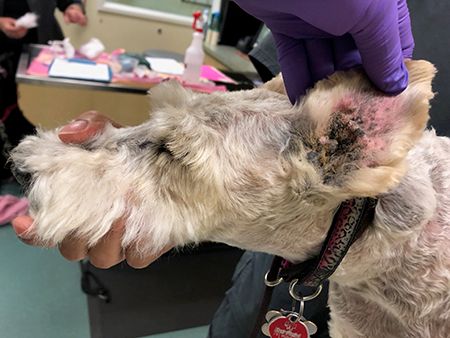Ears and allergies: A common couple in veterinary medicine
Why you might be just scratching the surface when addressing otitis in your patients.

This 11-year-old spayed female Wirehaired fox terrier has chronic atopic dermatitis and recurrent otitis externa, exhibiting active erythema, exudate, lichenification and significant proliferation along the opening of the external ear canal. (Photo courtesy of Dr. Melissa Hall)Ear disease is one of the most common reasons for a patient to be presented at the veterinary clinic. The pet owner may notice many different clinical signs, including odor, discharge, head shaking, ear scratching or pain upon touching or petting the ears. At times, it may be so severe that the pet is presented to the emergency services and even develop aural hematomas, requiring surgical intervention.
The cause of otitis can be tricky to ascertain since it's multifactorial, often complicated by inflammation and secondary microbial overgrowth and infection. Also, as patients experience recurrent infections, proliferation of the tissue and reactions to the medications can further muddle the diagnostic process.
Allergic diseases are reported as the most common cause of otitis, especially chronic otitis, responsible for 43% of cases.
Throughout the years, several classification systems have been used to help categorize and diagnose otitis externa. One of the most accepted and utilized systems is to try to identify four aspects of otitis externa: primary causes, secondary causes, perpetuating factors and predisposing factors. When using this system, hypersensitivities and allergies are considered a primary cause of otitis externa. In fact, allergic diseases are reported as the most common cause of otitis, especially chronic otitis, responsible for 43% of cases.1,2
In dermatology referral practice, about 75% of chronic otitis externa cases are associated with atopic disease, and the otitis may be the only sign of environmental allergies. Food-allergic dogs are also prone to increased incidence of otitis externa. In fact, one study showed that 55% of 65 food-allergic dogs had otitis externa, and often the clinical signs of otitis preceded other signs of food allergy in 34% of the cases.3 In some breeds like cocker spaniels and Labrador retrievers, chronic recurrent otitis may be the only clinical sign of food hypersensitivity.
So when approaching otitis in a patient, treating the secondary bacterial and/or yeast overgrowth is only scratching the surface since identifying and controlling as much as possible all the causes and factors will lead to a better clinical outcome. Many recurrent ear infections cases benefit from a full investigation into allergic triggers, including elimination diet trials and environmental allergy testing.
References
1. Saridomichelakis NM, Farmaki R, Leontides LS, et al. Aetiology of canine otitis externa: a retrospective study of 100 cases. Vet Dermatol 2007;18 (5):341-347.
2. Bensignor E, Legeay D: A multicentre prospective study of otitis externa in France: 802 cases. Vet Dermatol 11 (suppl 1), 2000;22:138-143.
3. Picco F, Zini E, Nett C, et al. A prospective study on canine atopic dermatitis and food-induced allergic dermatitis in Switzerland. Vet Dermatol 2008;19(3):150-155.